Hired’s annual wage gap report digs deeper into an ongoing problem: wage inequality in the tech industry. Black and Hispanic women continue to earn the lowest wages.
May 27, 2021
Inclusive Futures
Tech
Women and people of color continue to earn less than their white, male counterparts in tech jobs across the board, recruiting platform Hired’s 2021 wage inequality report showed. Despite some slow progress, the wage discrepancy persists across gender, race, age, sexuality, and education.
Though progress has been made across the industry, there’s still a long way to go.
“We continue to see that groups who are paid less also expect lower salaries than their white, male counterparts — even if they have the same experience,” Josh Brenner, the CEO of Hired, said. “These individuals can be stuck in a cycle of lower pay if they have no way of truly knowing how much they deserve in compensation for their role. Our data shows that simply offering everyone visibility into what a fair wage truly is would make a meaningful impact towards narrowing the gap.”
The fifth annual Hired report compiles data from more than 226,000 interview requests and job offers through its platform from 10,000 companies and 245,000 job seekers.
While the wage gap is slowly narrowing, discrepancies remain. Men were offered higher salaries than women for an equal role at the same company 59% of the time in 2020, according to the report. That’s down from 65% in 2019 and compares with 63% in the platform’s first-ever report in 2017.
In 2020, companies offered women an average of 2.5% less than their male counterparts for the same roles. That’s up from 4.4% less in 2019.
There are a number of factors including location that may contribute to the persistent wage gap, the Hired report found. In London, for example, the gender pay gap stands at 10%. That compares with 5% in San Francisco.
Though progress has been made across the industry, there’s still a long way to go.
“We continue to see that groups who are paid less also expect lower salaries than their white, male counterparts — even if they have the same experience,” Josh Brenner, the CEO of Hired, said. “These individuals can be stuck in a cycle of lower pay if they have no way of truly knowing how much they deserve in compensation for their role. Our data shows that simply offering everyone visibility into what a fair wage truly is would make a meaningful impact towards narrowing the gap.”
The fifth annual Hired report compiles data from more than 226,000 interview requests and job offers through its platform from 10,000 companies and 245,000 job seekers.
While the wage gap is slowly narrowing, discrepancies remain. Men were offered higher salaries than women for an equal role at the same company 59% of the time in 2020, according to the report. That’s down from 65% in 2019 and compares with 63% in the platform’s first-ever report in 2017.
In 2020, companies offered women an average of 2.5% less than their male counterparts for the same roles. That’s up from 4.4% less in 2019.
There are a number of factors including location that may contribute to the persistent wage gap, the Hired report found. In London, for example, the gender pay gap stands at 10%. That compares with 5% in San Francisco.
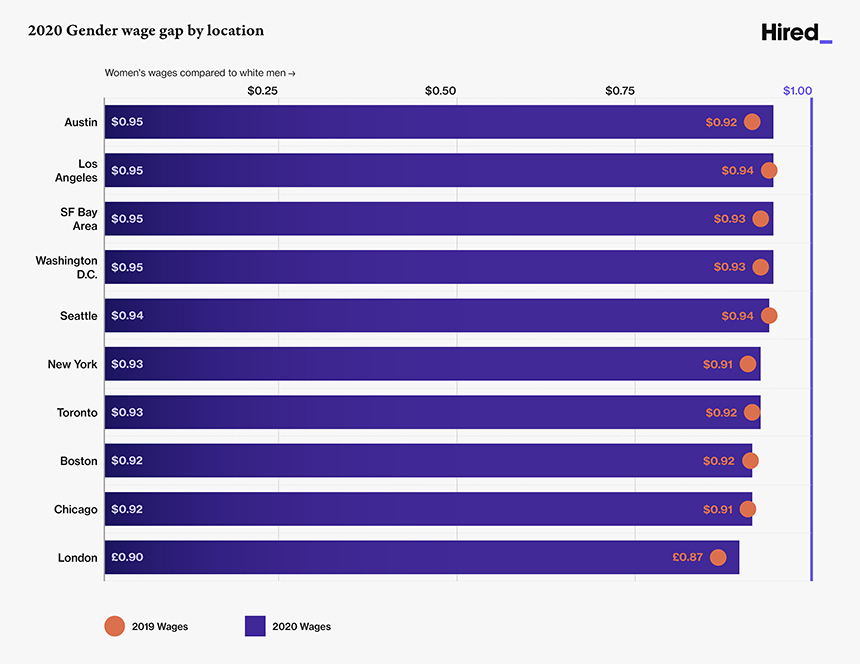
It's not all bleak, though. Black and Hispanic candidates were able to make up some ground on their white counterparts. Black candidates, for example, were offered 3.9% less than the baseline pay in 2020. By contrast, Asian candidates saw no change, receiving offers that were 1% lower in 2020 and 2019.
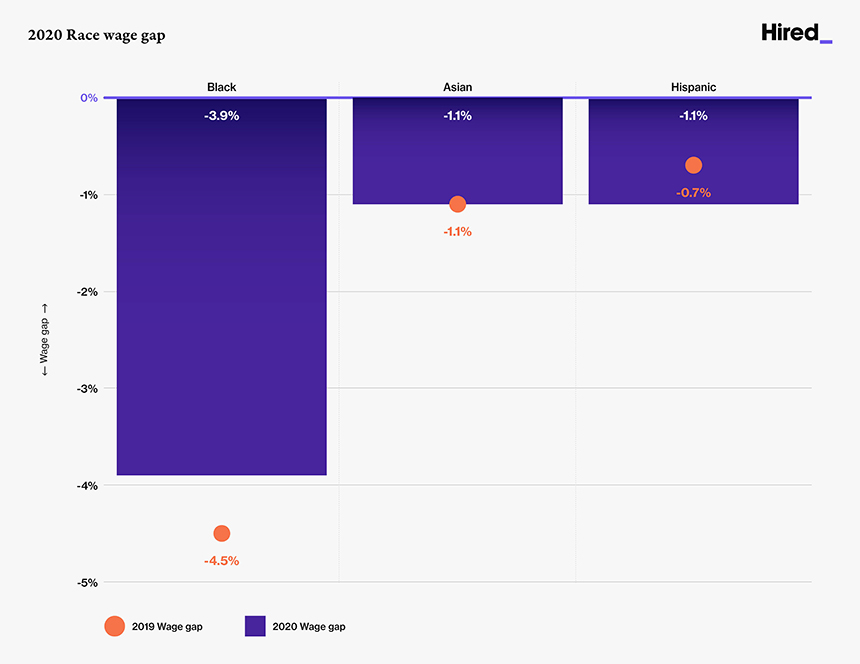
The Expectation Gap
There’s a strong correlation between the wage gap and the expectations gap, or, the notion that you will get paid less because of your gender or ethnicity. The Hired report found that many underrepresented groups expect to be paid less than their white, male counterparts – even if they have the exact same experience and background heading into the role. For example, Black women expect salaries that are on average 10% lower than those demanded by their white male counterparts.
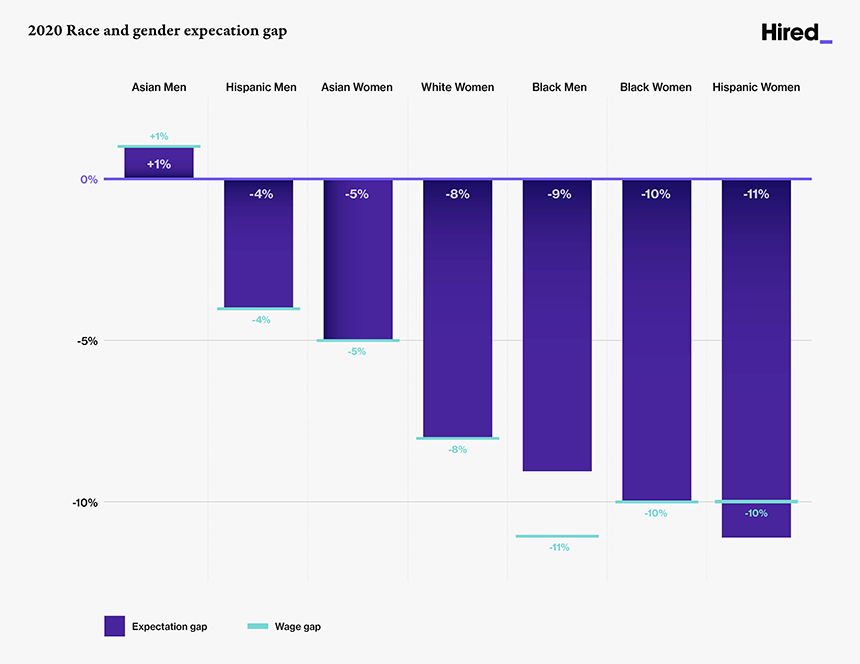
At the same time, the gender expectation gap decreased from 5.8% in 2019 to 3.2% in 2020, showing a clear correlation between the expectation and wage gap.
Men are less likely to believe in the wage gap than women and people of colour, Hired found. Only 36% of men reported experiencing discrimination, versus 57% of women making similar allegations. To that point, white employees are 28% more likely to get an increase in compensation when reporting a pay discrepancy; while the success rates for their Black and Hispanic counterparts are 20% and 15%, respectively.
Men are less likely to believe in the wage gap than women and people of colour, Hired found. Only 36% of men reported experiencing discrimination, versus 57% of women making similar allegations. To that point, white employees are 28% more likely to get an increase in compensation when reporting a pay discrepancy; while the success rates for their Black and Hispanic counterparts are 20% and 15%, respectively.
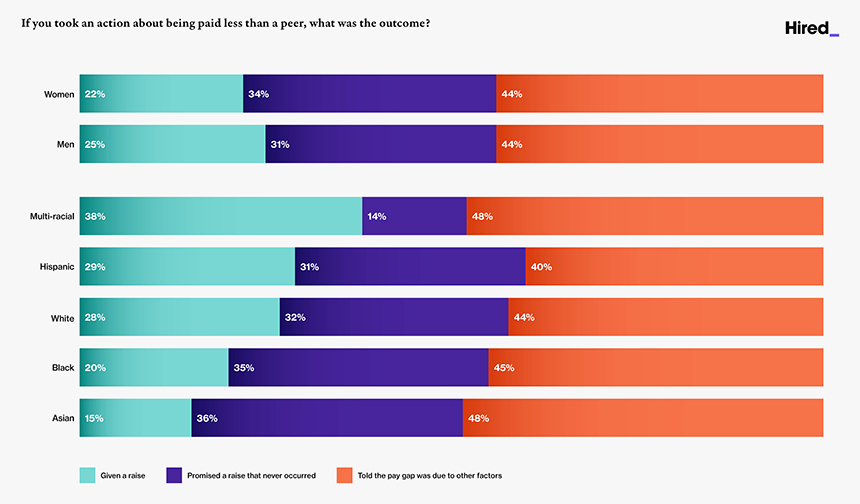
Diversity and Discrimination
Gender and race discrimination remain prevalent in the workplace, and it’s directly contributing to unequal pay, according to the report. Hired found that when entry-level employees are paid in an equal manner, it increases their chances of being paid fairly throughout their entire career.
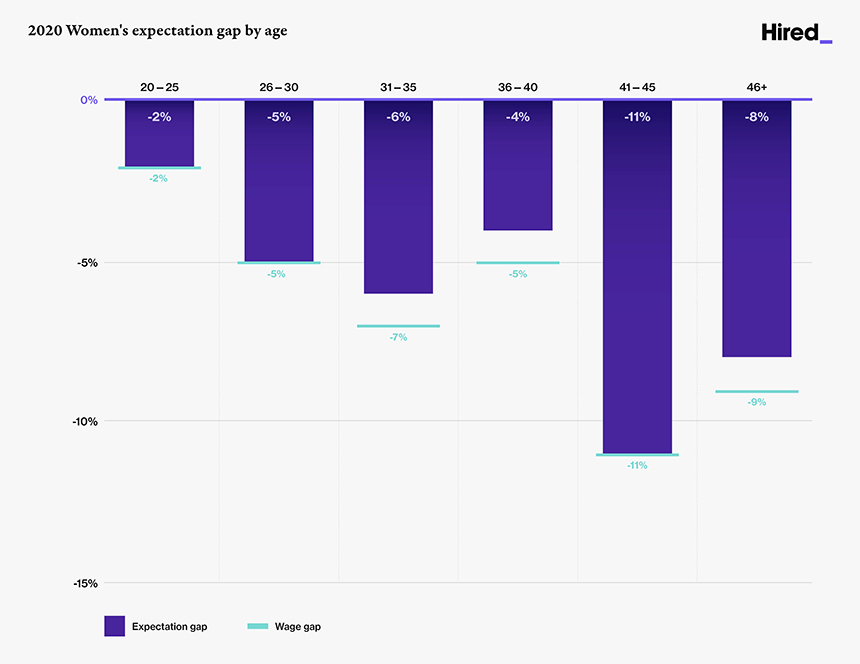
To that point, more than 70% of tech candidates believe employers need to increase salary transparency across their company. It would also result in reducing the expectation gap, which would have a profound, long-term impact on wage equality as a whole. It would also mark a milestone toward creating a more inclusive and transparent work environment.
“In 2021, employers must take action,“ Brenner said. “Tech employees today expect to be compensated based on their merit without being disadvantaged by their gender or race. Companies that won’t take meaningful steps towards lessening their wage gap risk losing out on top talent who demand forward-thinking and inclusive leaders.”
Prioritizing diversity and inclusion is more than a buzzword. For many companies, it will need to become a requirement to attract diverse, talented candidates, Hired found. In fact, salary transparency was identified as a clear talent retention issue. In short, if companies chose to take a more transparent salary approach, they wouldn’t only be saving costs but also contribute to higher employee satisfaction over the medium and long term.
Over 83% of survey respondents said that it is important that their employer takes steps to promote diversity and inclusion. And that means now more than ever, companies need to make a genuine commitment to advancing initiatives that foster equality if they plan to attract and retain top talent.
“In 2021, employers must take action,“ Brenner said. “Tech employees today expect to be compensated based on their merit without being disadvantaged by their gender or race. Companies that won’t take meaningful steps towards lessening their wage gap risk losing out on top talent who demand forward-thinking and inclusive leaders.”
Prioritizing diversity and inclusion is more than a buzzword. For many companies, it will need to become a requirement to attract diverse, talented candidates, Hired found. In fact, salary transparency was identified as a clear talent retention issue. In short, if companies chose to take a more transparent salary approach, they wouldn’t only be saving costs but also contribute to higher employee satisfaction over the medium and long term.
Over 83% of survey respondents said that it is important that their employer takes steps to promote diversity and inclusion. And that means now more than ever, companies need to make a genuine commitment to advancing initiatives that foster equality if they plan to attract and retain top talent.
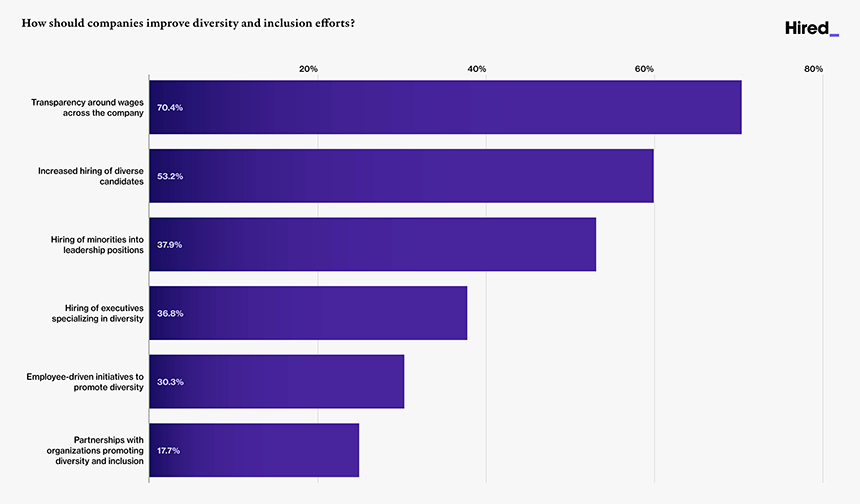
Read the full report here.



